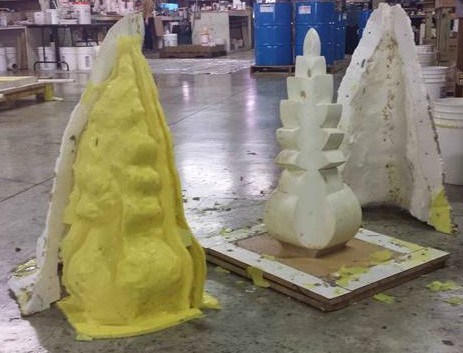What Are Shell and Mother Molds? Full Beginner Guide
When it comes to mold-making, getting great results isn’t just about having the right rubber or silicone. What often makes or breaks a casting project—literally—is the mother mold (also called a shell mold or support shell). These shell and mother molds form an outer layer that plays a crucial role in durability, accuracy, and cost efficiency.
Table of Contents
In this post, we’ll break down why shell and mother molds matter, how they improve your results, and some material options you can use—even if you’re working from a home setup. But before we do that, it’s worth covering safety, which is important in all mold-making projects and in many other areas of craft or hobby work.

Safety First: What to Know Before You Start When Making Shell and Mother Molds
When working with mold-making materials—especially those used for shell and mother molds like plaster, fiberglass, resins, cement, or gypsum-based products—basic safety precautions matter. These materials can produce dust, fumes, or skin irritants that are easy to overlook, even in smaller home projects.
Wear Protective Gear
Wear nitrile or latex gloves when handling silicone, resins, liquid plastics, or raw materials.
When mixing cement or gypsum, use long sleeves, safety goggles, and a dust mask or respirator to reduce exposure to dust and potential skin irritation.
If working with fiberglass, avoid direct contact with skin or eyes, as loose fibers can cause persistent itching or rash.
Dust and Ventilation
Cement and gypsum dust can cause respiratory irritation and long-term health issues if inhaled. And these are popular materials, especially the casting plaster, for shell and mother molds.
Work in a well-ventilated space, or wear a properly rated respirator when mixing dry materials or sanding and cutting cured molds.
Avoid mixing indoors unless proper exhaust or airflow is available.
Heat, Curing, and Surface Protection
Some casting resins and plastics used for shell and mother molds generate heat as they cure. Always place curing molds on heat-resistant surfaces and avoid handling during peak heat.
Plaster and cement can also heat up while setting, especially in larger volumes.
Prolonged skin contact with wet cement or plaster can result in alkaline burns or irritation, so avoid handling without gloves.
Clean-up and Disposal When Making Shell and Mother Molds
Clean your tools as soon as possible—especially when using plaster, cement, or silicone—before they harden.
Avoid pouring plaster or cement down sinks or drains, as these materials can set and block your pipes.
Dispose of unused materials according to local regulations, particularly resins and silicone, which may be classed as hazardous waste.
Bottom line:
Even small mold projects require a safe, considered approach. A few minutes of prevention can save hours of discomfort or damage to tools, materials, or health.
If you would like more details on safety in general, then folllow this link to another of our posts on safety, here.

1. The Strength Behind the Mold: Why a Mother Mold Is Essential
A mother mold is the rigid outer shell that supports your flexible inner mold. While the inner mold captures fine detail (usually using silicone, urethane, or latex), it can’t hold shape on its own. The mother mold provides structure, keeps everything aligned, and prevents warping or distortion during casting. It also helps reduce how much expensive rubber or resin you use, making the project more cost-effective.
Think of it as a supportive outer frame that preserves shape, detail, and function.
2. Using Locators for Perfect Alignment
Locator keys or notches in the mother mold help it fit precisely onto the inner mold. This ensures clean results, prevents movement, and avoids mismatched seams.
This becomes essential when working with multi-part molds, where even minor misalignments can lead to flawed castings.
3. Cost Benefits—Especially with Food Grade Silicone
If you’re using food-grade silicone or another premium material, a mother mold can reduce costs by allowing you to use less of it. Since the shell and mother molds are made of a cheaper rigid material, it supports a thinner rubber mold without compromising quality or detail.
This also reduces strain on the mold during demolding, leading to longer mold life.
- Less silicone used
- Lower overall costs
- Faster curing times
- Consistent results
4. Don’t Skimp on Coverage—Even for Smaller Shell and Mother Molds
Even small molds require proper coverage. If the rubber layer is too thin, it can tear or deform under pressure. Undercuts, textured surfaces, or deep grooves may require extra coverage to protect those areas.
Always make sure the rubber layer is thick enough before proceeding to build the shell and mother molds.
5. Shell and Mother Molds and Seamless Inner Molds (Sleeve/Glove Molds)
Mother molds are essential for supporting seamless inner molds—often called glove or sleeve molds—that slide over the original model. While these molds offer cleaner demolding, they’re very flexible and easily deformed during casting.
The outer shell keeps the form consistent and ensures the casting holds its intended shape.
6. Undercuts Require Special Attention
If your model includes undercuts or overhangs, extra care is needed in both the inner mold and the shell mold design. Rigid outer molds that don’t account for the flexibility needed to remove the inner mold can lead to tearing, breakage, or surface damage.
Plan ahead to avoid these issues during casting and demolding.
7. Using the Same Silicone with a Thickener (Brush-On Molds)
You don’t always need a second mold material. By adding a thickening agent (thixotropic additive), you can brush silicone directly onto your model to build up the inner mold.
Once that cures, you apply the mother mold right over it.
This method:
- Saves money on materials
- Gives better control on vertical or intricate shapes
- Keeps the workspace cleaner and more manageable
8. What to Use for a Mother Mold?
You have several options, depending on your budget, mold size, and intended use. Each comes with pros and cons.
- Plywood or MDF – low cost, limited durability unless sealed properly
- Plaster bandages – fast and cheap, best for small runs
- Casting plaster – longer life and better surface quality
- Fiberglass – lightweight, strong, ideal for repeat use
- Resin or liquid plastics – durable and highly detailed, but more expensive
- Lightweight concrete – cost-effective but heavy
- Metal – industrial use only, rarely used in small workshops
- Expanding foams or rigid resins – easy to apply, but more costly
Choose the material that fits your workflow, workspace, and the number of castings planned. And remember it is advisable that the shell mold last at least as long as the inner mold it protects.
Frequently Asked Questions
What is the difference between a mother mold and a shell mold?
They’re actually the same thing. Both terms refer to the rigid outer layer that supports the flexible inner mold. Some industries prefer one term over the other, but they serve the same function.
Do I always need a mother mold?
If you’re using a flexible inner mold made from silicone, urethane, or latex, the answer is usually yes — a mother mold is necessary to maintain shape, alignment, and detail during casting. With smaller molds or some made from firmer rubber, they aren’t always essential, except as protection for the mold itself.
What materials can I use to make a mother mold at home?
Common DIY materials include plaster bandages, casting plaster, fiberglass, lightweight cement, expanding foam, and resin-based products. Choose based on your mold size, detail level, and how many castings you plan to make.
Can I reuse a mother mold?
Yes — if it’s made from durable materials like fiberglass, resin, or sealed plaster. Take care not to damage alignment keys or edges during demolding. A well-maintained shell mold can greatly extend your mold’s working life and shelf life.
Is it safe to make mother molds indoors?
It depends on the materials. Cement, plaster, fiberglass, and resins all come with risks: dust, fumes, or heat during curing. Always follow safety guidelines, wear protective gear, and work in a well-ventilated space. Resin fumes can linger and cling to soft furnishings for days. Plaster and cement dust travel through a house easily — it really can feel like the builders have been in.
Final Thoughts
Mother molds aren’t the flashy part of the process, but they’re essential to long-lasting, accurate mold-making. They support your detail layer, protect the mold during casting, and save money over time.
Whether you’re casting resin, wax, cast stone, plaster or even soap, understanding how to plan and build a proper shell if the mold itself requires one, will improve your results and extend the life of your molds.
Contact Us
We hope you found this information on shell and mother molds helpful! If you have any questions or need assistance, feel free to reach out. Please note that due to government regulations, you’ll need to sign in and confirm your message. We apologize for any inconvenience.
Author: Rob
Ps. This is the company that taught me how to build this site and 3 others in 6 months, they keep their promises.

What is the difference between a mother mold and a shell mold?
They mean the same thing
Different industries prefer one of the terms
Do I always need a mother mold?
It is best when your core mold is flexible
The Harder rubbers or smaller pieces may not
What materials can I use to make a mother mold at home?
Casting plaster
Fiberglass
Lightweight concrete
Resin products
Liquid plastics
Expanding foam
Mold size dependent
Can I reuse a mother mold?
Yes, if made from durable materials
It should be made to last
Is it safe to make mother molds indoors?
It is product-dependent
Follow the manufacturer’s guidelines
Follow all safety precautions
Some products extremely messy


Great explanation! Shell and mother molds are crucial in casting processes. The shell mold is the outer layer that holds the shape, while the mother mold supports the shell during the casting process, ensuring it retains its shape. Perfect for beginners to understand how both molds work together to create precise, durable replicas. Thanks for breaking it down so simply!
Hi AJ,
Thank you for your comments, it is much appreciated.
Rob